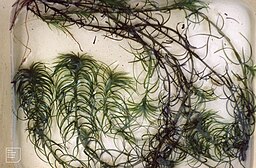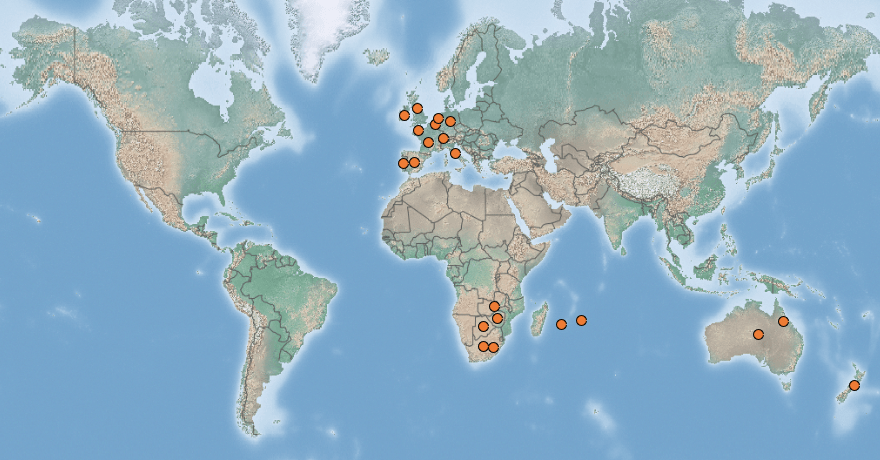 |
Curly waterweed | Status LU: present. 1st record: 2024 |
 |
Gekréngelt Waasserpescht | Status Eur.: established. 1st record: UK 1944.1 IAS of EU concern (2016). |
 |
Elodée crépue | RA: ISEIA: A1, Alert List. Harmonia+: 0,39. |
 |
Wechselblatt-Wasserpest | Wikipedia:    | Wikispecies: | Wikispecies:  | CABI | CABI |
 |
Verspreidbladige waterpest | Back to the list of neophytes |
Contents
Report the species
→ Report Lagarosiphon major to the National Museum of Natural History.
Brief description
 Lagarosiphon major Ridl. Moss ex Wager, Curly Waterweed, preferentially develops in clear, still or slow-flowing water systems. It can live in a wide range of trophic conditions providing that a silty or sandy bottom rich in nutrients is available. It prefers well-lit environments. The plant makes dense monospecific populations which often colonise whole water bodies, restrict water movement, cut off light, produce anoxic conditions and trap sediments in the system. The species has been reported to outcompete native aquatic plants and to affect associated populations of aquatic invertebrates and vertebrates. Dense beds provide a poor habitat for aquatic animals and are not consumed by fish. They interfere with recreational activities and increase the risk of adjacent land flooding (Branquart et al. 2013).
Lagarosiphon major Ridl. Moss ex Wager, Curly Waterweed, preferentially develops in clear, still or slow-flowing water systems. It can live in a wide range of trophic conditions providing that a silty or sandy bottom rich in nutrients is available. It prefers well-lit environments. The plant makes dense monospecific populations which often colonise whole water bodies, restrict water movement, cut off light, produce anoxic conditions and trap sediments in the system. The species has been reported to outcompete native aquatic plants and to affect associated populations of aquatic invertebrates and vertebrates. Dense beds provide a poor habitat for aquatic animals and are not consumed by fish. They interfere with recreational activities and increase the risk of adjacent land flooding (Branquart et al. 2013).
IAS of Union concern
In 2016, Lagarosiphon major Ridl. Moss ex Wager was added to the list of invasive alien species of Union concern (Anonymous 2016) which implies that member states shall take all necessary steps to prevent it’s unintentional introduction or spread.
Status and distribution in Luxembourg
The first documented observation of Lagarosiphon major Ridl. Moss ex Wager in Luxembourg was made in 2024 by Max Oly. The species was found on 26 August in a pond in the park of Munsbach Castle. Here are the observer’s comments. The population is located in a rather small and approx. 1 metre deep foil pond at the castle. The vegetation is quite natural with cattails, sedges and milfoil. The two invasive species (L. major and Crassula helmsii) have probably been deliberately introduced into the pond. Lagarosiphon is submersed and occupies a large part of the water body.
Risk assessment
ISEIA protocol
A1 (2+3+3+3) = Alert List (Ries et al. 2013: 18).
Harmonia+ protocol
Overall risk score 0,39 = (Overall Invasion score 0,60 x Overall Impact score 0,65) (Ries et al. 2020).
 Invasion
Invasion0,65

 Impact
Impact0,39

 Risk
RiskWorldwide distribution
Bibliography
- Anonymous, 2016. Commission implementing regulation (EU) 2016/1141 of 13 July 2016 adopting a list of invasive alien species of Union concern pursuant to Regulation (EU) No 1143/2014 of the European Parliament and of the Council. Official Journal of the European Union L 189: 4-5.
- Branquart, E., I. Stiers, L. Triest, S. Vanderhoeven, W. Van Landuyt, F. Van Rossum & F. Verloove, 2013. Harmonia database: Lagarosiphon major Ridl. Moss ex Wager. Harmonia version 1.2, Belgian Forum on Invasive Species. URL: http://ias.biodiversity.be [accessed on 2019-11-21]
- CABI, 2021. Lagarosiphon major. In: Invasive Species Compendium. Wallingford, UK: CAB International. URL: www.cabi.org/isc [accessed 2021-03-04]
- MNHNL, iNaturalist & GBIF, 2020. Lagarosiphon major in MNHNL-mdata, online portal combining species observation from Recorder-Lux, iNaturalist and GBIF. National Museum of Natural History, Luxembourg. URL: https://mdata.mnhn.lu [Accessed 2020-03-02]
- Ries, C., Y. Krippel & M. Pfeiffenschneider, 2020. Risk assessment after the Harmonia+ protocol of invasive alien vascular plant species in Luxembourg. Bull. Soc. Nat. luxemb. 122: 197-205. [PDF 132 KB]
- Ries, C., Y. Krippel, M. Pfeiffenschneider & S. Schneider, 2013. Environmental impact assessment and black, watch and alert list classification after the ISEIA Protocol of non-native vascular plant species in Luxembourg. Bull. Soc. Nat. luxemb. 114: 15-21. [PDF 652 KB]
Suggested citation of this webpage
Ries, C., M. Pfeiffenschneider & Y. Krippel (Eds.), 2026. Lagarosiphon major Ridl. Moss ex Wager. In: neobiota.lu - Invasive Alien Species in Luxembourg. National Museum of Natural History, Luxembourg. URL: https://neobiota.lu/lagarosiphon-major/ [Accessed 2026-01-20].
Page content last updated on 2024-10-03. Last proofread by Caroline Grounds on 2019-11-19.
- Cf. CABI 2021.[↩]


